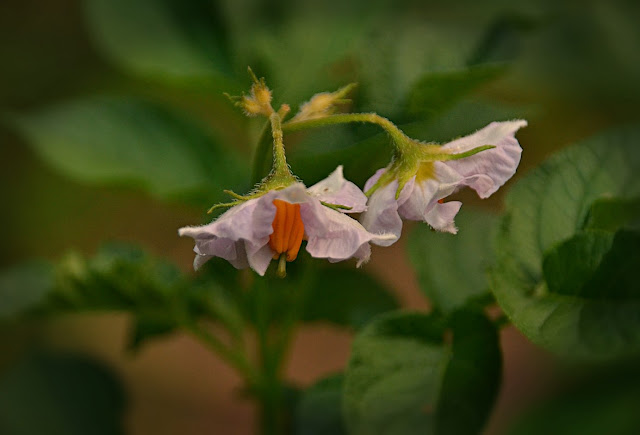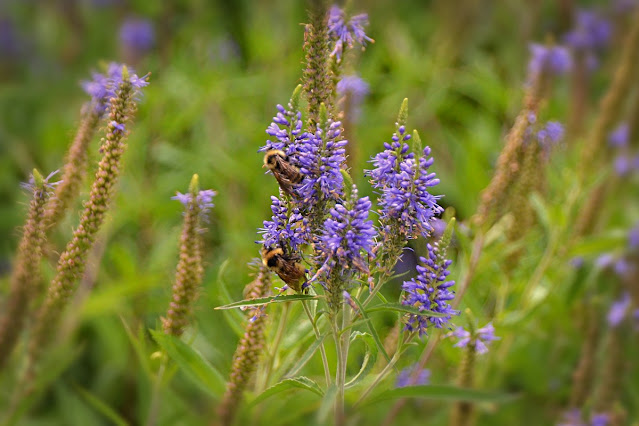(Among the ancient signs of the goddess Māra are black animals- fitting then for her day that the black bull seen above showed up just outside the acreage, in his summer pasturage on the farm- grumbling and bellowing across the way to his home turf on the neighbours' property, presumably there was a cow over there he wanted to get to. I wasn't that near, but he turned toward me right away as you see in the next photo- a wire fence wouldn't stop him if he came my way, I didn't stay in his line of sight for long!)
Another cross-quarter day has rolled around, meaning we've reached the beginning of another season in the traditional division of the year into eight parts (4 seasons, each with a beginning marked by a cross-quarter day, a middle marked by a solstice or equinox and a second part). In the Latvian traditon this day (variously noted as August 6 or 15) is named for Māra/Great Mother, an ancient goddess to some extent conflated with the Virgin Mary since Christian times. As a primary deity, she is given 4 days through the year. This one, called Summer Mara marks the end of summer, the beginning of Autumn, associated with harvest and abundance in many European cultures.
In more northerly or cooler places, like here in West Central Alberta. grains are ripening in the fields, but harvest of the fields is not quite here, yet. Gardens should be delivering yields. My planting efforts were a bit late and limited this year, so I don't have the peas I usually have but there should be some, soon, along with some beans, hopefully. Radish pods (delicious when young) are ripening and potatoes have begun to flower. More abundant are 'crops' I claim no credit for: weedy raspberries are everywhere and my planted ones are fruiting as well. Wild saskatoons are ripening, and I've been able to sample a few handfuls the Waxwings hadn't found yet. Wild currants and gooseberries (which pop up in garden beds too) have given me juicy handfuls and dogwoods too are everywhere- I snack on a few bitter white berries when I pass a bush on the way to check the mail. The sour cherries in the garden are just pre-peak ripeness- those are a bit large and hard to pull for the birds, so I usually have longer to eat those. Apples and Sorbus/Rowan/Mountain Ash are not quite there yet.
See videos that correspond to these photos (berries) a little farther down, Spectra/Peertube links as always at the end.
For each of the annual season beginnings/endings I focus on the signs in nature and garden of the shifts, the progression of the seasonal cycle of birth/germination/growth and flowering/seeding/senescence/death. We now see the early signs of Autumn: grasses and grains golding, plants going to seed, birds that have left the nest maturing, gathering, feeding for the migrations or long cold season ahead. Yet as the season of growth draws to a close, still there is much of life to celebrate: many flowers continue to bloom and others have just begun. They still buzz with bees, flies, wasps and butterflies even if more of those bees may be found sluggish or unmoving clinging to flowers on cool mornings or damp afternoons.
Now for the videos: meditative moments in the late summer garden, a short walk in the bush on the farm, and several short looks at some of the berry bounty of the season.
Short walk on the farm
Red-osier Dogwood
Skunk Currants
I finish with one of our several abundant wild Asters, flowers that begin in mid to late summer and carry on well past the early frosts of autumn. This one is a species in the genus Eurybia, named for one of the most ancient of Greek goddesses- ostensibly associated with sea but also with the movement of the stars, weather and winds- this suggests to me that she was one of the ancient nature deities, so a sister or even another name for, the Great Mother, Māra we celebrate here.
Comments on the ease of reading on this platform are welcome. I'm also starting to experiment with Wordpress. You can find me on
If you are able and would like to support me, I have a Ko-fi page; support helps me keep working-more research, more writing, more art!
(see this post for musings on support sites: https://cohanmagazine.blogspot.com/2021/01/fiction-feedback-and-finances.html ).
As usual, if you love an image, it could be loaded to any of the print on demand sites as cards, prints, mugs, clothing etc. Haven't played with any of those for a while, hope to get back at them soon.










Comments
Post a Comment